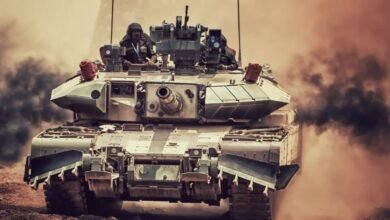Explained: The Evolution Of The Indian Army Uniform

Hello defence lovers! The Indian army is going to adopt its new uniform on this army day that is 15 January 2022. In this article, we are going to discuss how the uniform of the Indian army evolved during the centuries of its rich history. Let us start our discussion from the early days of East India Company and continue till
East India Company and The Scarlet Tunic

Soldiers of the East India Company
When the East India Company came to India and created its foothold in Bengal, it started recruiting native men into their army. The uniform worn by these soldiers reassembled the uniform worn by the soldiers who served the British crown. The red coat or the scarlet tunic was the standard uniform. In the early days’ traditional Indian dresses were also part of it. However, by 1857, the uniform became identical to that of other British empire soldiers. The vibrant red colour distinguished the British Indian troops from the French, Dutch and Portuguese soldiers. During this time period, the scarlet tunic became the representative of the Union Jack in the entire world. However, some Indian regiments also adopted different colours. The artillery Lascars of the Bombay army wore Royal Regiment of Artillery colours of Blue with red facings which were a true British Army tradition. The Bengal pioneers also wore green uniforms instead of red. However thus vibrant red colour made the British soldiers easy targets.
Transition To Khaki

British Indian troops during the First World War with the SMLE Lee Enfield rfiles
After the revolt of 1857, the British Indian Army slowly transitioned into khaki Uniforms from the traditional Scarlet Tunic. The Khaki was a far better choice than the traditional red as it was more comfortable to wear as it absorbed less heat and also helped in camouflaging in the dusty terrains of the Indian Subcontinent. By the 1890s Khaki had become the standard uniform of all British troops including British Indian troops. During the first and second world Wars, khaki uniforms remained the standard uniform. Indian troops were mostly deployed in the tropical regions and thus wore khaki shorts.
The Legendary Olive Green
After the Independence in 1947 Indian army adopted the Olive Green uniform. This was particularly done to distinguish Indian troops from Pakistani troops. Pakistan Army had retained the Khaki uniform which we can even see today in their modern ceremonial Uniform. From then onwards Olive green became synonymous with the Indian army. During the 1965 war and the 1971 Bangladesh liberation war, the plain olive green uniform was the standard combat attire of the Indian army. However, with the changing times, the Indian army felt the need to introduce camouflage patterns. Therefore Indian army adopted a new brush stroke camouflage uniform but retained the legendary olive greens as a duty uniform which we can see even today.

Olive Green General duty uniform
The Brush Stroke Camouflage
The Brush Stroke pattern was adopted by the Indian Army in the early 1980s. This was the first camouflage pattern introduced in the Indian army uniform. The camouflage pattern helped the soldiers to blend into their surroundings to avoid visual detection from a distance. In the above pictures, Dr APJ Abdul Kalam, the missile man of India along with other reputed scientists can be seen wearing the Brush Stroke pattern uniform. These pictures were taken during the Pokhran II nuclear tests.
PC DPM
In the early 2000s, the Indian army adopted the modern PC DPM camouflage pattern. Here DPM stands for Distributed Pattern Material. Around this time all modern militaries were innovating with camouflage patterns. It is the current combat uniform of the Indian Army. The PC DPM pattern is greatly inspired by the French Woodland DPM. The PC DPM pattern is perfect for most of the Indian conditions like dense jungles of the northeast and thick vegetation on LOC. However, this is not suitable for terrains like Rajasthan where desert camouflage patterns are more effective.
However, few branches of the Indian army have different uniforms. For example, the Military police have Khaki inform, the NSG aks “Blackcats” along with the armoured corp has a standard black uniform.

The new Indian army uniform will be unveiled in the Army day parade on 15 January 2022. The new uniform is an attempt to create a universal camouflage that will suit most of the terrains of India. A new duty uniform will be unveiled as well.



























